Fragrant water lily identification and control
Information about the noxious weed fragrant water lily. Fragrant water lily is also known by its scientific name, Nymphaea odorata.
About this weed
Fragrant water lily is a non-regulated Class C noxious weed. Due to how widespread it is, property owners are not required to control this species on their property, though it is encouraged. Fragrant water lily is also on the Washington quarantine list.
Fragrant water lily is known as Nymphaea odorata, and another common name is American white waterlily. It is in the water lily family, Nymphaeaceae.
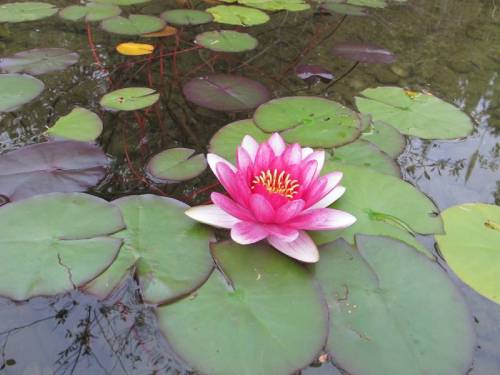
Why it's a noxious weed
-
Drownings in King County have been attributed to swimmers getting tangled in dense water lily stems.
-
Fragrant water lily fouls boat motors and restricts passage for non-motorized boats.
-
Stagnant mats create mosquito breeding areas and increase water temperatures.
-
Fragrant water lily can contribute to algal growth and water quality problems.
-
When areas of fragrant water lily eventually die, they can result in areas of floating mud-mats.
-
Fragrant water lily spreads quickly and widely.
-
One rhizome (root system that spreads outwards and can grow new stems) can cover up to a 15-foot diameter circle in five years.
Plant description
Fragrant water lily is a perennial (plants that have a 2+ year life cycle), floating-leaved aquatic plant, found in 2 to 8 feet deep water. It grows in freshwater lakes, ponds and slow-moving streams and ditches. Fragrant water lily can tolerate a wide range of pH but prefers mucky to silty lake/pond bottoms. They spread by both plant fragment and seed.
Fragrant water lily's leaves float on the water's surface, sitting atop long flexible stalks that extend from large root systems in the mud. Leaves are nearly circular in shape but have a notch to the center, making a “pac-man shape”. They're leathery, green, and grow up to 1 ft across.
Flowers are showy, white to pink with yellow centers and are aromatic. Flowers bloom from Jule to October. After they're fertilized, flower stalks curl like a corkscrew, pulling the flower underwater. The seeds then float back up to the surface and are spread through water movement.
Fragrant water lily’s thick, fleshy rhizomes (root system that spreads outwards and can grow new stems) and can spread vegetatively when rhizome fragments break off. These root systems are extensive and difficult to navigate, which poses a great risk for humans and animals who come into contact with them.
The plant dies back in the fall and decays on the water's surface.
Fragrant water lily is native to eastern North America but not Washington State.
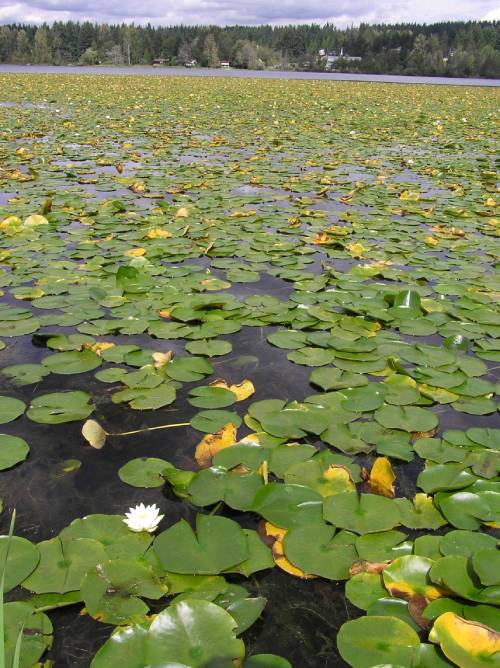
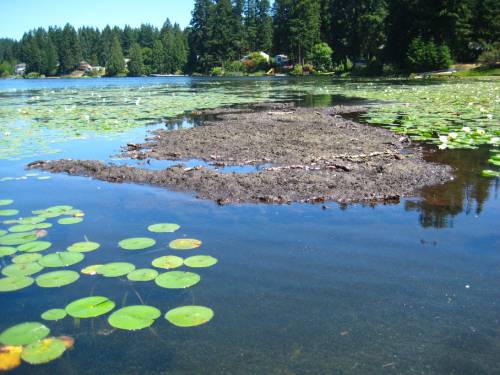
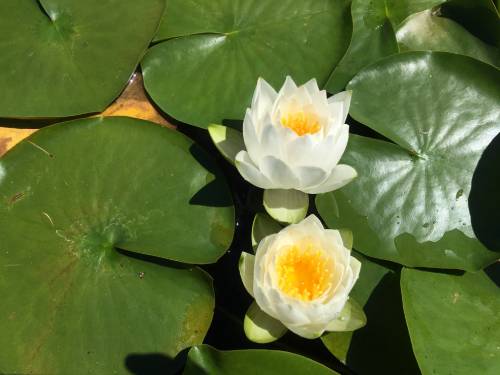
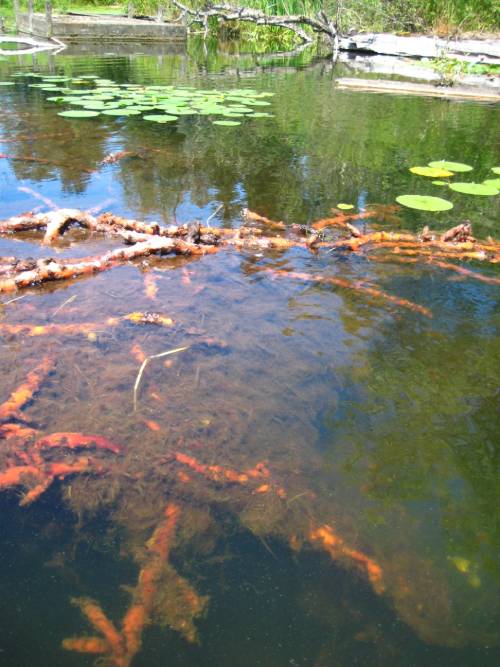
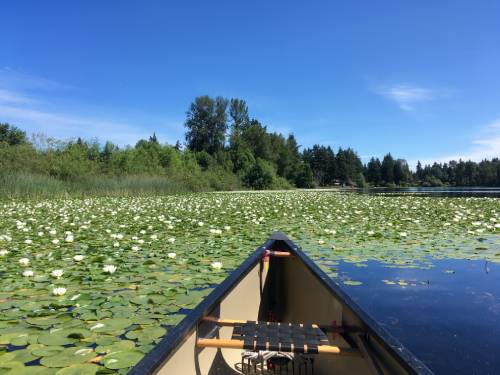
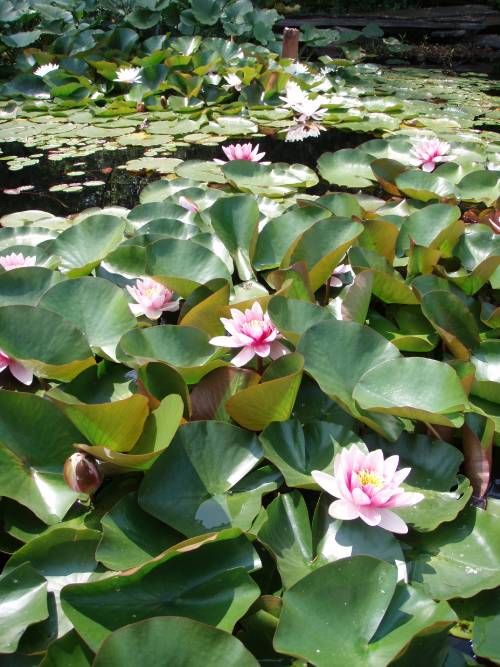

Be aware of look-alike plants
Fragrant water lily is most often confused with:
Spatterdock (Nuphar polysepala), also known as yellow pond lily, is a native plant which has large heart-shaped leaves and bright yellow, cup-shaped flowers, and stiff stems that hold the leaves out of the water later in the summer.
Water-shield (Brasenia schreberi), is a native plant which has smaller, slimy-coated leaf bottoms and stalks with the stem attached to the center and not having a slit.
Yellow floating-heart (Nymphoides peltata) is a noxious weed that can look very similar to small fragrant water lily leaves. Yellow floating-heart has slightly heart shape leaves that only get up to 10 cm across and flowers with a distinctive yellow fringe.
When in doubt, take photos and report them on iNaturalist.
What to do if you find it
Because fragrant water lily is so widespread, property owners in King County are not required to control it. King County is not generally tracking infestations. We can provide advice on how to control water lily, but there is generally no legal requirement to do so. The King County Noxious Weed Control Board encourages property owners to remove water lily where possible, and to avoid introducing it to new landscapes.
This plant is often distributed through movement of watercrafts and water related equipment. Make sure you inspect your watercraft at the boat launch before entry and after exit to avoid spreading any invasive or nuisance aquatic plants or animals. See King County’s boating information web page for more information.
Control methods
We recommend using a combination of methods to control weeds. In areas with few weeds, it is important to act quickly before they become harder to control. Make a long-term plan as it often takes several years to get rid of most weeds. Start in the least infested areas first and then move into more heavily infested areas.
For more in-depth control information, read Best Management Practices (BMP) for fragrant water lily
Manual control
Aquatic plant control that does not involve herbicide requires a (free) permit. The rules and regulations for this type of removal will depend on your circumstance, please visit the WA Dept Fish and Wildlife for access to their Aquatic Plants & Fish Pamphlet and guidance on how to use it properly.
-
Small patches in shallow water can be dug up, making sure to collect all root and stem fragments.
-
In deep water and for larger patches, leaves and tops of stems can be removed by hand or with cutting tools.
-
Effective removal should be repeated very regularly (weekly during the growing season) over two to three years.
-
This plant can be composted on land or disposed of in yard waste bins.
-
A bottom barrier can be used to suppress growth in small areas such as a boat launch or around a swimming area. This method requires a permit from WA Dept of Fish and Wildlife.
Cultural control
Herbicides may be the most cost-effective option for eradication of large infestations. Professional, licensed contractors are available for hire for this method.
Chemical control
Stay safe when using herbicide:
- Always read the label before use.
- Wear a long-sleeved shirt, long pants, shoes, and eye protection.
- Follow state and local regulations.
Avoid spraying where there is a chance that herbicide will enter a waterway or wetland unless you are using a state-approved aquatic herbicide and have the required permits and licenses to do so. Use of pesticides in water is regulated in Washington state. See Washington Department of Ecology Aquatic Pesticide Permits for details.
For more information or a site-specific recommendation in King County, contact the noxious weed program. For information in other locations, contact your local weed board or extension office.
Disposal instructions
Pulled water lily leaves can be composed on site in dry areas upland or disposed of in commercial yard waste.
Noxious Weed Disposal - Washington State Noxious Weed Control Board

 Translate
Translate